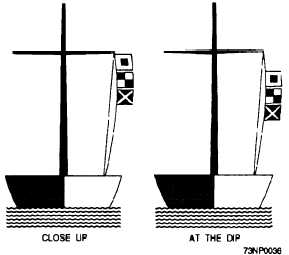FLAGHOIST TERMINOLOGY
LEARNING OBJECTIVES: Explain flaghoist
terminology and the use of it when
communicating with flaghoist.
Every rating has its own vocabulary; the
Signalman rating is no exception. You may already be
familiar with some of the terms discussed in this
section.
Signal flags are stowed in the flag bag. It is not
actually a bag, but derives its name from the metal
frame covered with canvas, in which flags formerly
were stowed. Most ships today are equipped with
all-metal bags, which are fireproof and afford more
protection for the flags.
Halyards are numbered from outboard to inboard
(1, 2, and so on). Hence, No. 1 starboard would be the
outboard halyard on the starboard yardarm.
When the end of a hoist gets away from you and
flies out of your reach, you can recover it by using a
retriever. A retriever is a separate line attached by a
metal ring to each halyard. The retriever may be
moved up and down by separate lines attached as part
of such rigging.
The Signalman who keeps a lookout for signals
and calls them out to personnel handling the flags at
the flag bag is called the spotter. The spotter will call
out, “Stand by your bags,” when a signal is being made
on another ship. That warning tells those personnel on
the bags that a signal is being made and they should
be ready to repeat it. The spotter calls out the complete
hoist twice, then calls out, “Going up.”
An example of an incoming signal is as follows:
The spotter calls out, “Stand by your port/starboard
bag. Signal in the air from the OTC. First hoist,
BT—FORM 3, I say again BT—FORM 3, going up to
the dip; second hoist, CORPEN STBD 275, I say again
CORPEN STBD 275, going up to the dip; third hoist,
SPEED 15—T13, I say again SPEED 15—T13, going
up to the dip. End of hoist, end of signal.”
Signal flags are bent onto the uphaul part of the
halyard. The piece of halyard that is made fast to the
last flag in a hoist (so the flags can be hauled down) is
called the downhaul. When personnel on the bags have
the downhaul secured to the last flag and are ready for
the signal to be hoisted, they tell the person on the
uphaul to “Take it up.”
HOISTING SIGNALS
A flaghoist is said to be “closed up” when its top
is touching at the point of hoist. The point of hoist is
the block attached to the yardarm through which the
halyard carrying the hoist is rove. It is the highest point
to which the signal can be raised. Signals when hoisted
by the originator are normally hoisted closed up.
A flaghoist is said to be “at the dip” when hoisted
three-fourths of the way up to the point of hoist
(fig. 5-3). Flaghoists made in answer to or to repeat
the original signal are normally hoisted at the dip until
understood; then they are hoisted close up. Relaying
ships are always to repeat the flaghoist at the dip until
it has been acknowledged by the ships for which they
are responsible, after which they close up the signal.
A flaghoist is said to be “hauled down” when it is
returned to the deck. The moment of hauling down is
the moment of execution unless the time of execution
is otherwise indicated. The signal is to be acted upon
as soon as understood, or the signification of a signal
indicates that it is to be executed on dipping.
Best results are achieved in flaghoist commun-
ication when signals can be made as a single hoist and
hauled down before another signal is hoisted. If the
hoist is too long (when it cannot be displayed on one
halyard), it is to be broken where a tack would
normally be inserted. If the entire signal cannot be
made on three halyards, it is usually advisable to make
two or more hoists. When this is done, the heading is
hoisted and left flying close up until completion of the
signals.
Figure 5-3.—Flaghoist close up and at the dip.
5-4



